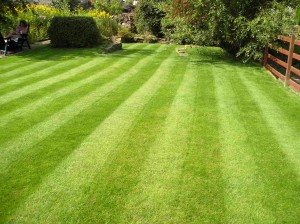 Aerating, mowing, watering, fertilizing – there are a lot of jobs to keep track of if you want a perfect lawn. And when should you do them? This maintenance calendar gives you a run-down month by month so you can be sure you’re right on schedule.
Aerating, mowing, watering, fertilizing – there are a lot of jobs to keep track of if you want a perfect lawn. And when should you do them? This maintenance calendar gives you a run-down month by month so you can be sure you’re right on schedule.
This calendar applies for most areas, but your local conditions might be a little different. For the best results, heed the notes on temperature and weather conditions as they apply to your area.
January
- Get your lawn equipment prepared for the season. This is usually a slow time for shops, so it’s a good time to schedule any work you can’t do yourself.
- Keep walkways clear to avoid treading on frozen grass, which can lead to bald spots.
- Try to use salt only when necessary. Buildup on soil can hinder plant growth.
February
- Once the soil has thawed and dried out, collect a soil sample for testing. This should give you the information you need for amending the soil.
- Rinse off areas that have been heavily salted as well as your pets’ potty areas. Dog urine is particularly acidic and can kill grass if left undiluted.
March
- Treat moss growth. Moss growths are caused by problems with your lawn, but if you follow this schedule, most issues, including poor mowing and fertilization practices, should be alleviated.
- Rake the lawn to remove debris, grass, and any remaining leaves. This will help the grass dry out faster and provide the roots with better access to nutrients.
- Add nutrients and soil amendments as suggested by the last soil test.
April
- Start mowing once the first growth appears. The first few times, cut less than you normally would and dispose of any clippings to cut down on the chance of fungal infestation.
- Apply pre-emergent herbicides to keep weeds from growing. Weeds like crabgrass usually start germinating once the daily high temperature is above 55-60 degrees F (13-16 degrees C.)
- Seed the lawn, filling in bald spots.
May
- Mow normally, leaving the clippings on the lawn.
- Spot treat weeds that survived the first herbicide treatment.
- Fertilize the lawn.
June
- Start watering at a rate of one inch per week.
- Let the grass grow to a height of three to four inches before mowing. The added shade from the tall grass will protect the turf from heat.
July
- Treat the soil with pesticides.
August
- Test the soil again for nutrient correction.
- Dethatch the grass and aerate the soil to ensure water and oxygen access.
- Overseed. The seed should be applied at least one and a half months before the first frost is expected.
September
- Fertilize the soil to give cold weather grasses a boost.
- Spot treat broadleaf weeds, or use a “weed & feed” combination herbicide and fertilizer. Avoid using weed & feed on newly planted grass.
- Gradually return to normal mower cutting height, never cutting more than 1/3 of the total grass height at one time.
October
- Add nutrients and soil amendments as suggested by the last soil test.
- Collect or mulch falling leaves to keep the soil exposed.
- Reduce watering to one inch every two weeks.
November
- Mow until the grass stops growing. Make the final mow a little lower than normal to help the grass resist mold and rodent damage.
- Keep watering, keeping an eye on the soil to ensure it isn’t wet when the first snow falls.
December
- Winterize your lawn equipment.
Where to Get Parts for Your Cub Cadet Equipment
Whether you’re getting geared up for the next year or need to fix some equipment in the middle of summer, you can get everything you need from www.cubparts.com. We’re a certified Cub Cadet dealer carrying parts for everything from weed eaters to garden tractors, and we can ship what you need to any address in the U.S. and Canada.
